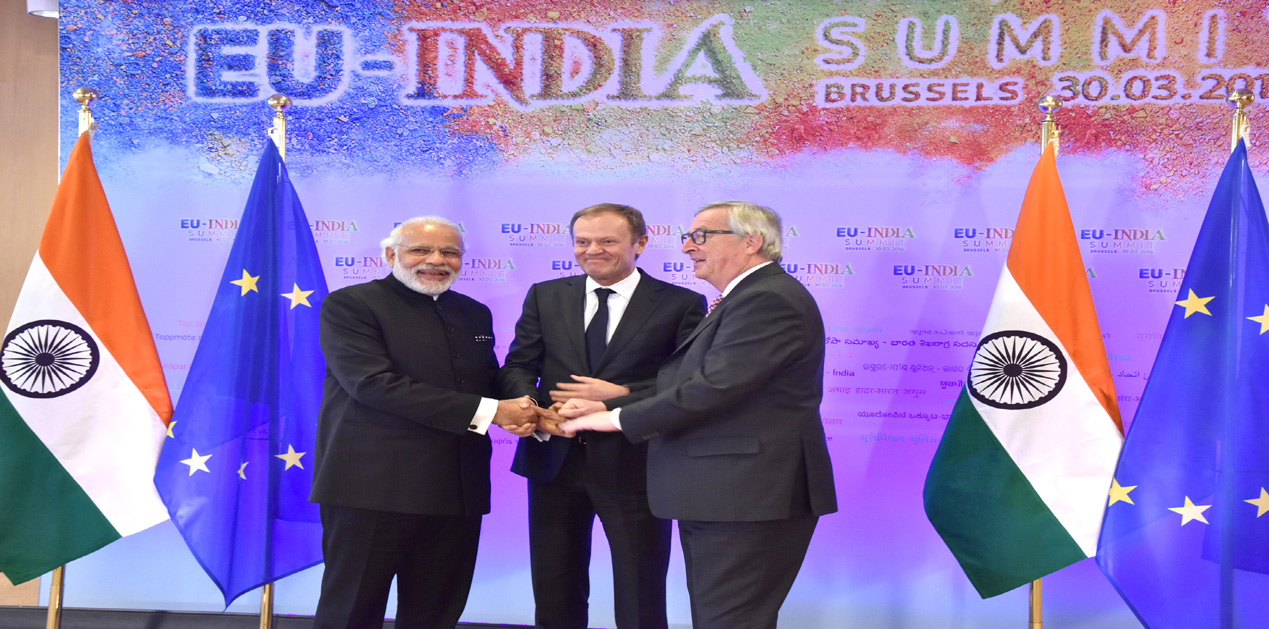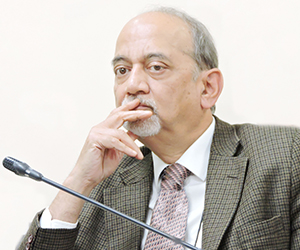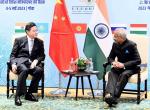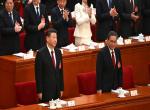The Summit
The 14th European Union (EU)-India Summit was held in New Delhi on 6th October, 2017. It showed the maturity of the process that began in 2000 with Lisbon Summit. Both the partners have gone through major changes since. The EU expanded in 2005 to include East European countries. The economic slow-down of 2008 onwards tested its cohesion. Despite the challenge of 'Brexit', and the migrant crisis, EU remains an important partner for India. India has since grown into a 3 trillion dollar economy. It was already a pre-eminent power in South Asia; its stabilizing role has grown internationally.
The main outcome of the Summit was the Joint Statement. There were three other documents adopted - Joint Declarations on Counter-terrorism, Climate and Energy and partnership for smart and sustainable urbanization.
The Joint Statement contained separate paragraphs on Afghanistan, Myanmar, nuclear accord with Iran, Democratic People's Republic of Korea (DPRK), Syria, Middle East Peace Process, Libya and Ukraine. There was also an extensive section on trade and economic co-operation. While they underlined agreement on wide spectrum of issues between EU and India, this is pegged at relatively low threshold, and does not reflect full potential of their relationship. What could be the reasons? It is always difficult to give trade concessions at a time of economic uncertainty. There are also internal issues of EU decision-making.
The EU’s position on foreign policy issues are part of Common Foreign and Security Policy (CFSP). They represent ‘common’ positions of EU member States on foreign and defence issues. The EU does not have ‘a’ foreign and defence policy per se. The distinction is important. Behind it lies the tension between national sovereignty and Union, which implies some measure of pooling of sovereignties. Since the economic slow-down, and migrants crisis, the balance has tilted towards national positions. Major EU member states, particularly P-5, have always given primacy to their own national decisions on foreign policy issues.
On Afghanistan, the two sides expressed support to an Afghan led and Afghan owned peace process. The EU appreciated the positive role being played by India in extending development assistance to Afghanistan. The EU itself provides development assistance to Afghanistan. Together with its Member States, the European Union contributes more than €1 billion in development assistance per year to Afghanistan. However, the issue goes beyond economic development. An ‘Afghan led’ and ‘Afghan owned’ peace process is difficult to sustain in face of terrorist violence by groups based in Pakistan, and drawing support from State agencies. The Joint Declaration on counter-terrorism mentions some of these groups. But this is an annex to the main document, and the reference is not linked to situation in the Af-Pak region.
EU and India affirmed their support to continued full implementation of the Joint Comprehensive Plan of Action (JCPOA). The joint statement ‘recognised confirmation by the IAEA that Iran is complying with its nuclear related JCPOA commitments. The statement came at a crucial stage, when President Trump was preparing to de-certify the agreement. He has done so on 14th October.
The Joint Statement condemned the nuclear test conducted by DPRK on 3rd September 2017, and called for de-nuclearization of the Korean peninsula. Interestingly, the statement ‘stressed the responsibility of those who support DPRK’s continued pursuit of nuclear and ballistic programmes’.
The Joint Statement contained a positive reference to India’s accession to the Missile Technology Control Regime (MTCR). However, it was somewhat muted in its reference to India’s intensified engagement with Nuclear Suppliers’ Group (NSG), where EU contained itself to ‘noting’ India’s actions.
Maritime security co-operation in the Indian Ocean also figured in the statement. Though there was a reference to the Freedom of Navigation in accordance with the universally recognized principles of international law, notably the United Nations Convention on the Law of the Sea (UNCLOS), this was without linkage to specific situation or region. The statement also made positive references to India’s contribution to UN Peace-keeping and India-Africa Summit process.
Terrorism
Terrorism figured both in the Joint Statement, as well as a separate Joint Declaration on the subject. While the paragraph in the joint statement dealt with principles, the joint declaration on the subject referred to specific incidents in India and Europe. They also named the terrorist groups of concern to India, including Hafeez Saeed, Zaki-ur-Rehman Lakhvi, Dawood Ibrahim, the Lashkar-e-Tayibba, Jaish-e Mohammad, Hijbul Mujahideen, Haqqani Network, Al Qaeda, the Islamic State (Da’esh) and their affiliates.
The paragraph, however, did not mention origin, and supporters of these terror groups. The protection enjoyed by these groups from Pakistan military, is not only a source of worry for India or Afghanistan. This was also a major area of conflict between the civilian government and military in Pakistan. Nawaz Sharif has since then be eased out, in what could best be described as a judicial coup. But the problem will continue to haunt the political leadership, and civil society in Pakistan. It will also continue to queer the pitch for any peaceful solution in Afghanistan. It is noted that EU is not without considerable leverage in Islamabad, which receives aid as well as trade concessions.
Trade and Investment
The two way trade in goods between India and EU exceeds 77 billion euro, with a small surplus of 1.6 billion Euro in India’s favour. The two way trade in services was Euro 28.5 billion with a small surplus of 0.8 billion Euro in India’s favour (EU exports 13.8 billion; EU imports 14.7 billion). (Source: Eurostat).
The Joint Statement mentioned establishment of a branch of European Investment Bank (EIB) in India. EU is a net investor in terms of Foreign Direct Investment (FDI) in India. EU’s investment in India increased to Euro 6.2 billion in 2015. Indian investment flow in EU reached Euro 1.1 billion. On cumulative basis, EU’s FDI in India was Euro 62.8 billion, while Indian FDI in EU was Euro 14.7 billion (Source: Eurostat). This level of trade and investment is far below the two countries’ potential. It is also far below EU-China trade. China has a much larger foot-print in trade and economic terms. However, India offers a more open, and transparent market to EU exports.
The Joint Statement noted the ongoing efforts to re-launch negotiations for a comprehensive and mutually beneficial India-EU Broad Based Trade and Investment Agreement (BTIA), without indicating a specific time-frame.
In the long, run co-operation in technology is perhaps no less important than trade and investment. The Joint Statement referred to enhancing India-EU Space Co-operation, including Earth Observation. This is again an instance of pegging our sights too low. The European Space Agency has a very successful programme, under which it has landed a probe Huygens on a Titan, Saturn’s moon. The Indian Space Research Organisatio (ISRO) has successfully mounted its 'Mars Mission', and emerged as a reliable satellite launcher. The two sides can do more. On a bilateral level, ISRO already has a more ambitious programme of co-operation, for instance with France.
The Joint Statement referred to EU Frame-work Programme for Research and Innovation ‘Horizon 2020’ and Indian programmes. The statement also ‘encouraged’ Euratom and the Department of Atomic Energy to conclude the agreement for research and development in the field of the Peaceful Uses of Nuclear Energy. Here again, the two sides can do more. Co-operation with India could provide EU industry with opportunities, when nuclear energy programme in most EU countries is at a pause. India is already participating in programme International Thermo-nuclear Experimental Reactor (ITER).
EU-China Summit
It will be interesting to have a look at EU’s co-operation with China. The 19th EU-China Summit held in June 2017 in Brussels ended without a Joint Statement. China’s insistence that EU recognize her as a ‘market economy’, and the row over Chinese steel exports, blocked the final statement. However, absence of ‘market economy’ status has not impeded China running a surplus of Euro 175 billion with EU. Chinese exports to EU were Euro 345 billion, and imports Euro 170 billion in 2016 (Source: Eurostat). The two way trade between the two is Euro 515 billion in 2016, as against Euro 77 billion in case of EU-India trade. China is the second largest EU trading partner after the United States.
China has emerged as a net investor in EU in 2015. During the year, Chinese direct investment flows in EU stood at Euro 6.3 billion, while EU investment flows in China were Euro 6 Billion. (Source: Eurostat). On a cumulative basis, EU FDI in China reached Euro 168 Billion, while Chinese FDI in EU was Euro 35 Billion (Source: Eurostat).
EU’s Foot-prints in South Asia
India’s co-operation with the European Commission (EC) started in the 80s under Community’s assistance programme. The most successful example was ‘Operation Flood’, which provided support to India’s dairy industry. As Indian economy grew, the salience of development co-operation was reduced, and market access, investment and technology assumed greater importance. However, trade and development assistance from EU remains critical to many of our neighbours, especially Nepal, Bangladesh, Pakistan and Sri Lanka. The EU is Sri Lanka's largest export destination, absorbing 36% of its exports. It accounts for nearly half of Bangladesh’s total exports.
The EC has granted Pakistan Generalised Special Preference - Plus (GSP+) status under which 76 percent of Pakistani exports, including textiles, enter EU duty and quota free. This represents 20 percent of Pakistani exports globally. This gives EC enough leverage to move Pakistani policies in a more responsible direction. This will not be a concession to India, but promote human rights, democracy and governance in that country. These are also the conditions precedent for grant of GSP + status.
EU and India share a common commitment to a multi-lateral, rule based system. They will need each other more in the coming years. Apart from interaction with EU institutions, India also has strong relationship with individual Member States of the European Union. More needs to be done to strengthen both.
(The writer has served as Minister (Political) in Indian Mission in Brussels, and Ambassador to Czech Republic)
Image Source: https://mediaindia.eu/business-politics/india-europe-business-outlook/











Post new comment